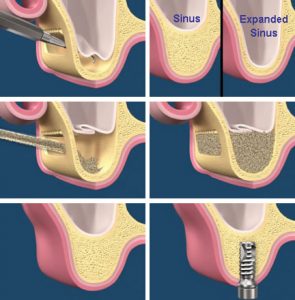ORAL SURGERY
Third molars, commonly referred to as wisdom teeth, are usually the last four of 32 teeth to erupt (surface) in the mouth, generally making their appearance between the ages of 17 to 25. They are located at the back of the mouth (top and bottom), near the entrance to the throat. The term wisdom” stems from the idea that the molars surface at a time typically associated with increased maturity or "wisdom".
In most cases, inadequate space in the mouth does not allow the wisdom teeth to erupt properly and become fully functional. When this happens, the tooth can become impacted (stuck) in an undesirable or potentially harmful position. If left untreated, impacted wisdom teeth can contribute to infection, damage to other teeth, and possibly cysts or tumors.
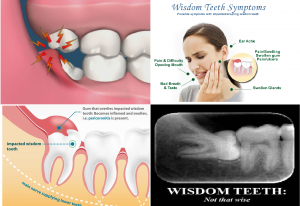
There are several types, or degrees, of impaction based on the actual depth of the teeth within the jaw:
- Soft Tissue Impaction:
The upper portion of the tooth (the crown) has penetrated through the bone, but the gingiva (gum) is covering part or all of the tooth’s crown and has not positioned properly around the tooth. Because it is difficult to keep the area clean, food can become trapped below the gum and cause an infection and/or tooth decay, resulting in pain and swelling. - Partial Bony Impaction:
The tooth has partially erupted, but a portion of the crown remains submerged below the gum and surrounding jawbone. Again, because it is difficult to keep the area clean, infection will commonly occur. - Complete Bony Impaction:
The tooth is completely encased by jawbone. This will require more complex removal techniques.


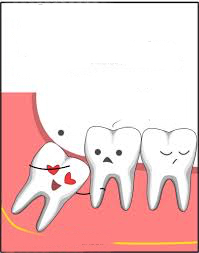
While not all wisdom teeth require removal, wisdom teeth extractions are most often performed because of an active problem such as pain, swelling, decay or infection, or as a preventative measure to avoid serious problems in the future. If impaction of one or more wisdom teeth is present, and left untreated, a number of potentially harmful outcomes can occur, including:
- Damage to nearby teeth:
Second molars (the teeth directly in front of the wisdom teeth) can be adversely affected by impacted wisdom teeth, resulting in tooth decay (cavities), periodontal disease (gum disease) and possible bone loss. - Disease:
Although uncommon, cysts and tumors can occur in the areas surrounding impacted wisdom teeth. - Infection:
Bacteria and food can become trapped under the gum tissue, resulting in an infection. The infection can cause considerable pain and danger.
As with any dental procedure, your dentist will want to initially conduct a thorough examination of the wisdom and surrounding teeth. Panoramic or digital x-rays will be taken in order for your dentist to evaluate the position of the wisdom teeth and determine if a current problem exists, or the likelihood of any potential future problems. The x-rays can also expose additional risk factors, such as deterioration or decay of nearby teeth. Early evaluation and treatment (typically in the mid-teen years) is recommended in order to identify potential problems and to improve the results for patients requiring wisdom teeth extractions. Only after a thorough examination can your dentist provide you with the best options for your particular case.
What does the removal of wisdom teeth involve?Wisdom teeth removal is a common procedure, generally performed under local anesthesia, intravenous (IV) sedation, or general anesthesia by a specially trained dentist in an office surgery suite. The surgery does not require an overnight stay, and you will be released with post-operative instructions and medication (if necessary), to help manage any swelling or discomfort.
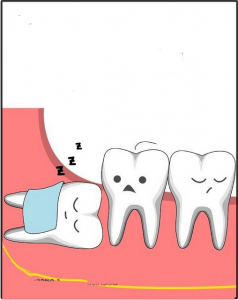
Bone grafting is often closely associated with dental restorations such as dental implants. In the majority of cases, the success of a restoration procedure can hinge on the height, depth, and width of the jawbone at the implant site. When the jawbone has receded or sustained significant damage, the implant(s) cannot be supported on this unstable foundation and bone grafting is usually recommended for the ensuing restoration.
There are several major factors that affect jaw bone volume:
- Periodontal Disease.
Periodontal disease can affect and permanently damage the jaw bone that supports the teeth. Affected areas progressively worsen until the teeth become unstable. - Tooth Extraction.
Studies have shown that patients who have experienced a tooth extraction subsequently lose 40-60% of the bone surrounding the extraction site during the following three years. Loss of bone results in what is called a "bone defect". - Injuries and Infections.
Dental injuries and other physical injuries resulting from a blow to the jaw can cause the bone to recede. Infections can also cause the jaw bone to recede in a similar way.
Bone grafting is a highly successful procedure in most cases. It is also a preferable alternative to having missing teeth, diseased teeth, or tooth deformities. Bone grafting can increase the height or width of the jawbone and fill in voids and defects in the bone.
There are essentially two basic ways in which bone grafting can positively impact the health and stability of the teeth:
- Jaw Stabilization.
Bone grafting stabilizes and helps restore the jaw foundation for restorative or implant surgery. Deformities can also be corrected and the restructuring of the bone can provide added support. - Preservation.
Bone grafting can be used to limit or prevent bone recession following a tooth extraction, periodontal disease, or other invasive processes.
Initially, the dentist will thoroughly examine the affected area in order to assess the general condition of the teeth and gums. If periodontal disease is present or the adjacent teeth are in poor condition, these factors will be fully addressed before the bone grafting procedure can begin. The dentist will also recommend panoramic x-rays in order to assess the precise depth and width of the existing bone. On occasion, a CAT scan may be recommended to determine the bone condition. Depending on these results, the dentist may also anesthetize the area and explore into the gum in order to determine what kind and how much bone is required.
What Does Bone Grafting Involve?There are several types of bone grafts. Your dentist will determine the best type for your particular condition.
- Autogenous Bone Graft.
Harvested from the patient’s own body (usually from the posterior part of the lower jaw or the chin). This method is usually preferred because it produces the most predictable results. - Allograft Bone Graft.
Cadaver or synthetic bone is used in this type of graft. - Xenograft.
Cow bone is used in this type of graft.
The bone grafting procedure can often take several months to complete. Bone is typically harvested from your own body (or on rare occasions obtained from a “bone bank”) and added to the affected site. This bone will fuse with the existing bone and the migration of cells will cause firm adhesion and cell growth. Supplementing the jaw with bone will result in greater bone mass to help support and anchor the implant(s).
During the surgery, the dentist will numb the grafting and extraction sites using local anesthetic. A small incision will be made to prepare the site for the new bone and it will be anchored into place. On occasion, a synthetic membrane may be used to cover the new bone. This membrane prevents soft tissue and bacterial invasions, and encourages new bone growth. The surgery does not require an overnight stay, and you will be provided with comprehensive instructions for your post-operative care. The dentist will prescribe medications to help manage infection, discomfort and swelling.
Despite improvements in dental care, dental implants are replacement tooth roots. Implants provide a strong foundation for fixed (permanent) or removable replacement teeth that are made to match your natural teeth.
Dental implants offer a natural solution to replace teeth lost due to trauma, decay, disease or old age. Replacing missing teeth improves the oral health as well as the functionality of the teeth, enhances smile and self-esteem. A dental implant is a small titanium screw root, which is fitted into the socket of the missing teeth that looks and functions like the real ones and can be used to replace a single tooth or several teeth.
The missing teeth can be replaced immediately by placing the implants directly into the available bone. With the use of angled, and/or max implant technology, is less likely to require bone grafting.
What Are the Advantages of Dental Implants?There are many advantages to dental implants, including:
- Improved appearance:
Dental implants look and feel like your own teeth. And because they are designed to fuse with bone, they become permanent. - Improved speech:
With poor-fitting dentures, the teeth can slip within the mouth causing you to mumble or slur your words. Dental implants allow you to speak without the worry that teeth might slip. - Improved comfort:
Because they become part of you, implants eliminate the discomfort of removable dentures. - Easier eating:
Sliding dentures can make chewing difficult. Dental implants function like your own teeth, allowing you to eat your favorite foods with confidence and without pain. - Improved self-esteem:
Dental implants can give you back your smile and help you feel better about yourself. - Improved oral health:
Dental implants don’t require reducing other teeth, as a tooth-supported bridge does. Because nearby teeth are not altered to support the implant, more of your own teeth are left intact, improving long-term oral health. Individual implants also allow easier access between teeth, improving oral hygiene. - Durability:
Implants are very durable and will last many years. With good care, many implants last a lifetime. - Convenience:
Removable dentures are just that; removable. Dental implants eliminate the embarrassing inconvenience of removing dentures, as well as the need for messy adhesives to keep them in place.
Success rates of dental implants vary, depending on where in the jaw the implants are placed but, in general, dental implants have a success rate of up to 98%. With proper care (see below), implants can last a lifetime.
Can Anyone Get Dental Implants?In most cases, anyone healthy enough to undergo a routine dental extraction or oral surgery can be considered for a dental implant. Patients should have healthy gums and enough bone to hold the implant. They also must be committed to good oral hygiene and regular dental visits. Heavy smokers, people suffering from uncontrolled chronic disorders-such as diabetes or heart disease- or patients who have had radiation therapy to the head/neck area need to be evaluated on an individual basis. If you are considering implants, talk to your dentist to see if they are right for you.
Our Implants are the clear choice for patients seeking fast, efficient and high quality dental implant services, performed only by highly trained and experienced dentist.
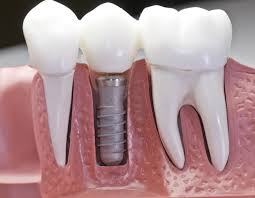
A dental implant is essentially an artificial tooth root which is attached to the jaw bone. Eventually, a replacement tooth or bridge will be firmly fixed to this root, restoring complete function to the tooth. The key to a successful and long-lasting dental implant is the quality and quantity of jawbone to which the dental implant will be attached. If bone has been lost due to injury or periodontal disease, a sinus augmentation, also called a sinus lift, can raise the sinus floor to allow for new bone formation.
In the most common sinus augmentation technique a tiny incision is made near the upper premolar or molar region to expose the jawbone. A small opening is cut into the bone and the membrane lining the sinus on the other side of the opening is gently pushed upward. The underlying space is filled with bone graft material and the incision is closed. The bone which is used for this procedure may be from your own body or from a cadaver. Sometimes the dentist might use synthetic materials which can also stimulate bone formation. The implants are placed after healing has occurred; this will depend on the individual case. Sinus augmentation has been shown to increase the success of dental implant procedures.
